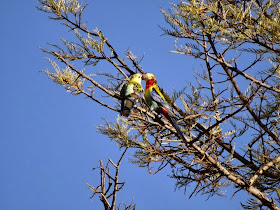The Silky Oak trees were vibrant throughout this trip; seen along roadsides and on farming properties. Tall growing, and covered in flowers like this. An Australian native, the largest Grevillea type, grows up to 30 metres (almost 100 feet).
Various birds were using them; Noisy Friarbird
Rosella
feeding in the uppermost branches
adding this delightful Little Friarbird, though it wasn't sitting in the Silky Oak, there is one flowering directly behind it









They don't look much like oaks but they certainly attract some beautiful and interesting birds.
ReplyDeleteHi John, apparently also known as Australian Silver Oak, not closely related to the Quercus Oak you know over there
ReplyDeleteI love how our native plants are so attractive to our birds. you have some lovely shots of both Silky Oak and birds here.
ReplyDeleteLovely birds with nice colors Carole...... your pictures are very good.
ReplyDeleteGreetings, Joop
All them are beautiful, but, the last, Little Friarbird is superb, well spotted Carole.
ReplyDeleteI draw much attention, how do you see so many birds. A lovely photos especially the last one, with the Little Friarbird. A kiss Carole and Have a nice weekend :)
ReplyDeleteThe silky oaks are an interesting tree. Love the colors of the flowers. It's always a delight to see your birds!
ReplyDeletevery pretty trees. :)
ReplyDeleteThat is an interesting leaf structure for a tree being an oak. Wonderful bird photos as always.
ReplyDeleteYou have make beautiful photos, Carole!
ReplyDeleteGreetings, RW & SK
thanks everyone for your comments. Gumer "how do you see so many birds" you asked. Became interested to try photographing birds about two years ago. The more you get out and search for them, the more you 'get lucky' and see them. Exploring new locations is always a treat in search for 'new birds' you mightn't get to see near to home base. I'm finding that the more I get out and listen to them, the more familiar I become with their calls too making it easier to locate a bird and know its ID when photographing (if I can get that wonderful opportunity). It can be a little daunting, they have a mind of their own and won't often stay where you want them to :) but it's a big buzz if it works.
ReplyDeleteWhat a pretty tree- I don't guess I have ever seen one before. Wonderful shots of the birds too.
ReplyDeleteLovely trees, love the silky oaks. The Rosellas are sure beautiful.
ReplyDeleteWhat gorgeous and showy trees!!!!! TFS Carole!
ReplyDeleteBeautiful trees! And so are the Rosella's! Really nice shot of the Friarbird!
ReplyDeleteWe're beginning to see the Silky Oak used in landscaping here in the U.S. Hope it will attract as many beautiful birds as it appears to down under!
ReplyDeleteHope your weekend is going well, Carole.
Have never seen this amazing type of oak Carole. so unusual, but it really looks as if the birds love it, and you have gotten some incredible shots of these colorful birds. Love your post.
ReplyDeleteHi Carole I love your native plants and the birds you find in them especially love the Rosellas
ReplyDeleteGreat set of shots! I do like the rosellas.
ReplyDeleteAccording to the same source as is used by our Minister for the Environment (!) some Yellow Admirals do overwinter as adults. Having said that, I included it in the post because I have always thought it was true - not because I knew it to be true (if you see what I mean!)
Cheers - Stewart M - Melbourne
The tree looks amazing Carole but the Rosellas steal the show...
ReplyDelete